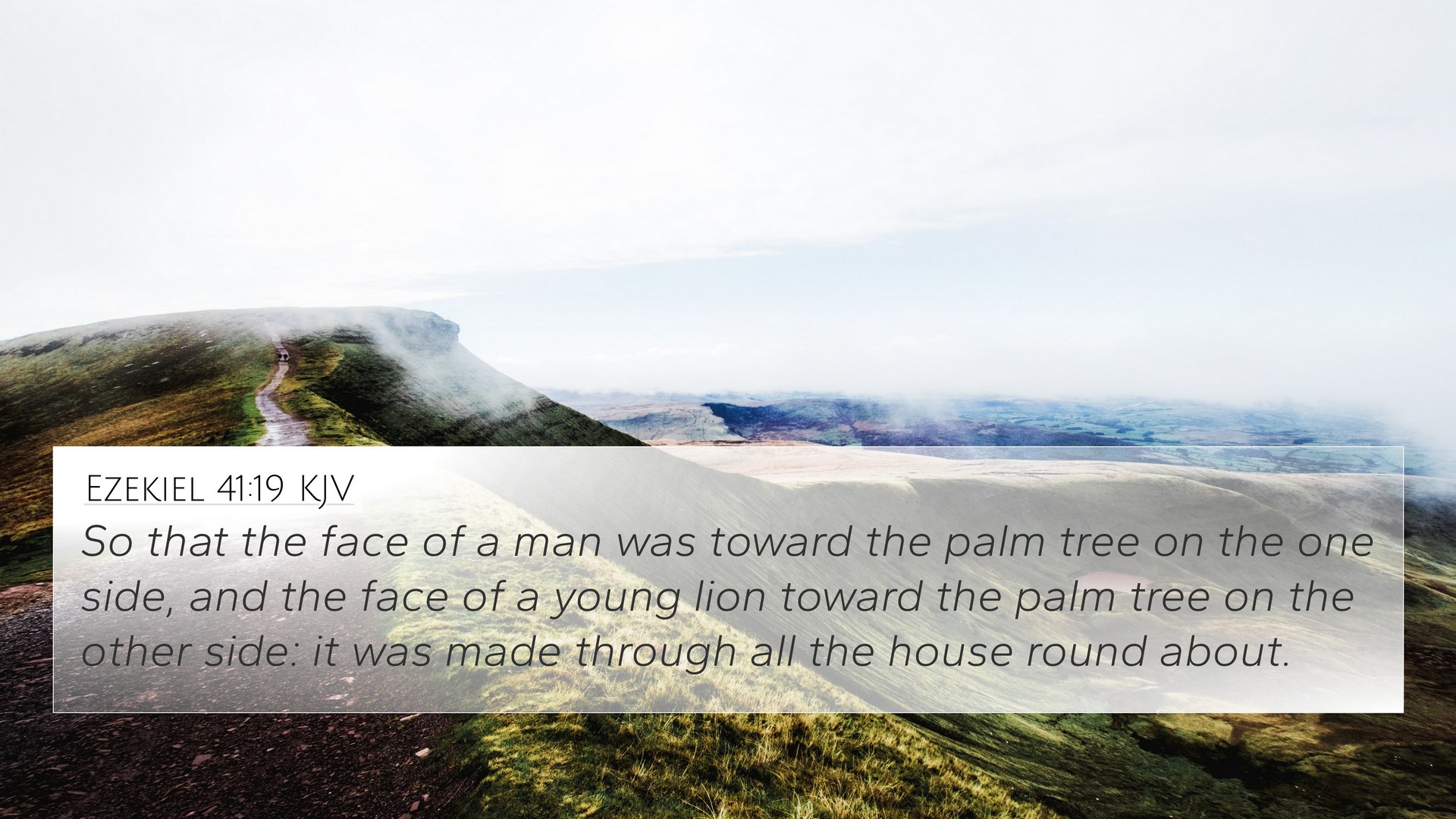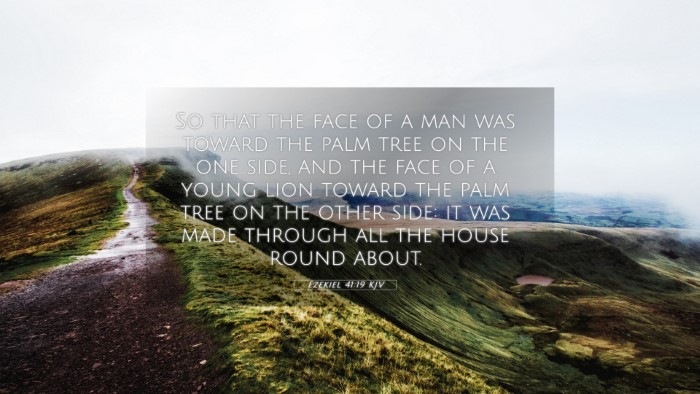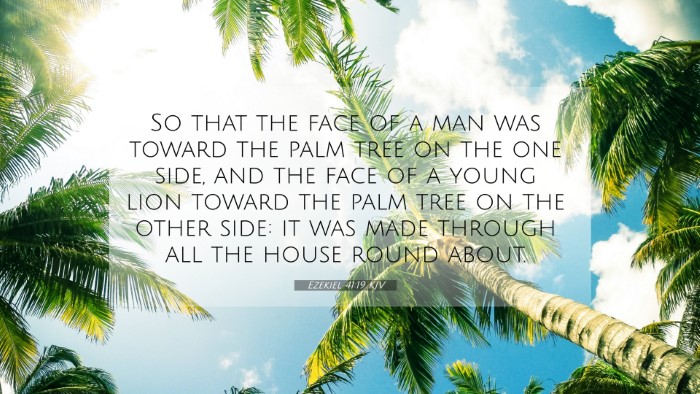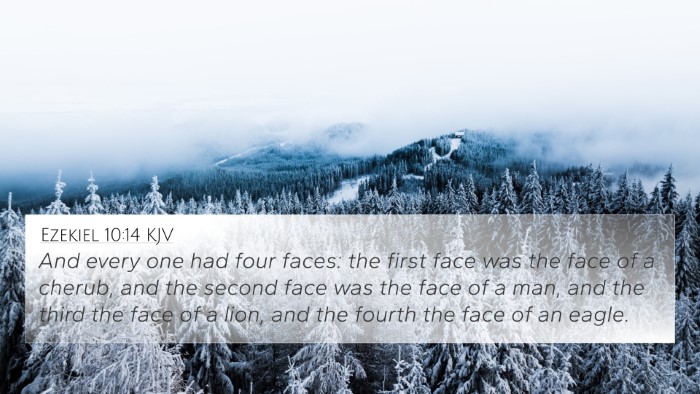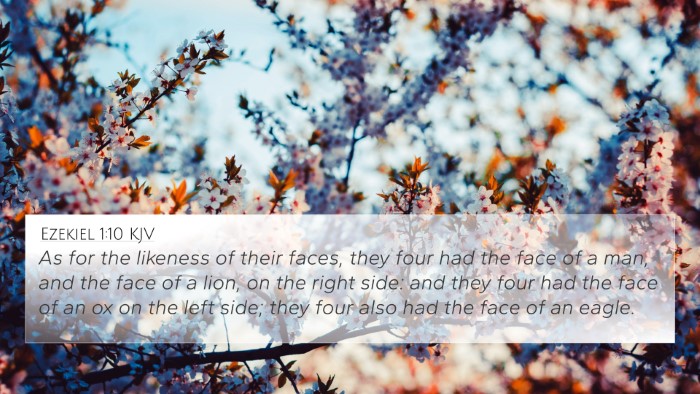Ezekiel 41:19 - Meaning and Interpretation
Ezekiel 41:19 reads: "And the face of a man was toward the palm tree on one side, and the face of a young lion toward the palm tree on the other side: thus was the place of the temple."
This verse provides rich imagery and symbolism within the context of Ezekiel's vision of the temple, illustrating the intricate design and the spiritual significance of the features described.
Summary of Insights
The interpretation of Ezekiel 41:19 encompasses various themes viewed through the lenses of public domain commentaries. Matthew Henry, Albert Barnes, and Adam Clarke provide a harmonized understanding of this verse, which can be beneficial for Bible study and interpretation.
Symbolism in Ezekiel 41:19
The "face of a man" and the "face of a young lion" mentioned in the verse symbolize attributes of both humanity and divinity. The presence of these symbols near the palm trees may indicate a connection between strength, authority, and the nurturing aspects of God.
Matthew Henry's Commentary
Matthew Henry emphasizes that the temple's design was divinely inspired, reflecting the glory of God. He notes that the palms symbolize victory and peace, serving as a reminder of God's provision and the eternal life available in Him.
Albert Barnes' Commentary
Albert Barnes interprets the imagery presented in this verse as a means of demonstrating the characteristics of majesty and benevolence. He connects the lion's face to the might and power of God and the man’s face to the Divine oversight and relationship with humanity.
Adam Clarke's Commentary
Adam Clarke discusses the symbolism of the young lion and the man, suggesting they represent Christ, who embodies both authority and compassion. Clarke highlights the architectural components of the temple as symbolic of God’s kingdom on earth.
Thematic Bible Verse Connections
To enhance understanding, several Bible verses can be cross-referenced with Ezekiel 41:19, exhibiting thematic connections:
- Revelation 5:5: Represents the Lion of the tribe of Judah, echoing the strength of the lion in Ezekiel.
- Psalm 92:12-14: Discourses about the righteous flourishing like palm trees, relating to the palm imagery in Ezekiel.
- Ezekiel 1:10: The four living creatures, which include human and lion faces, linking back to the imagery in our verse.
- Jeremiah 50:17: The connection with lions and God's might throughout the history of Israel.
- Matthew 21:8: The triumphal entry of Christ, symbolizing victory associated with palm branches.
- 1 Peter 5:8: The adversary, named as a roaring lion, lends to understanding the lion's characteristics.
- Luke 19:40: The stones crying out resonates with the themes of the created world proclaiming God's glory.
Cross-Referencing Biblical Texts
The practice of cross-referencing helps in uncovering deeper meanings and thematic links. Utilizing a Bible concordance or cross-reference guide can greatly enhance one's study.
Tools for Cross-Referencing
- Bible Concordance: A valuable tool for locating specific verses and exploring connections.
- Cross-Reference Bible Study: Methods enabling focused examination of interrelated themes across scriptures.
- Bible Reference Resources: Materials aiding in studying scriptures contextually.
Identifying Connections
Understanding how the verses relate to one another can significantly enhance the comprehension of Biblical narratives and teachings. For instance, examining the parallels between the Old and New Testaments can reveal continuity in God's message.
Example: Links Between Old and New Testament
Ezekiel's vision of the temple foreshadows the New Testament understanding of the temple as the body of Christ and the spiritual temple of believers (1 Corinthians 6:19).
Inter-Biblical Dialogue
Investigating how various scriptures converse with each other can provide profound insights into Biblical theology. For instance, comparing themes found in the Prophets and the Apostolic writings may uncover deeper meanings surrounding God’s Kingdom.
Conclusion
By studying Ezekiel 41:19 and engaging with cross-referenced verses, readers can enjoy a rich, multifaceted insight into the nature of God, His temple, and the character of worship. Engaging with public domain commentaries supports a deeper understanding of scripture, facilitating personal growth and faith enrichment.
